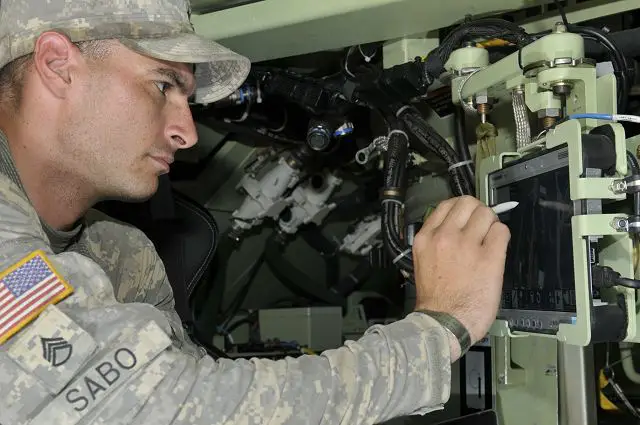U.S. soldiers test upgrade of M2A3 Bradley IFV with cameras to increase situational awareness 11407152
|
|
|||
|
Military Defense Industry Technology - Upgrade of Bradley M2A3
|
|||
|
|
|||
| U.S. soldiers test upgrade of M2A3 Bradley IFV with cameras to increase situational awareness. | |||
|
U.S. Soldiers, with Company A, 2nd Battalion, 7th Cavalry Regiment, 3rd Armored Brigade Combat Team, 1st Cavalry Division, tested a new capability for the the Bradley M2A3 Armoured Infantry Fighting Vehicle, June 25. The budding capability is designed to be installed into existing armored vehicles to give troopers inside a 360-degree picture of what's going on around them.
|
|||
|
|
|||
 Staff Sgt. Michael Sabo, a mounted section leader with Company A, 2nd Battalion, 7th Cavalry Regiment, 3rd Armored Brigade Combat Team, 1st Cavalry Division, demonstrates the capability of a tablet mounted in the back of an M2A3 Bradley Fighting Vehicle on Fort Hood, Texas, June 25, 2015.
|
|||
|
|
|||
|
Soldiers riding in the back of an M2A3 Bradley Fighting Vehicle are confined to a relatively small space, and have to wait for the ramp to lower before dismounting. After it lowers, they are exposed immediately to whatever awaits them. The more information they have about their surroundings before exiting, the better they can quickly orient themselves, identify where they need to go, and find cover. "When the ramp drops on the Bradley, there is a moment of disorientation," said Maj. Stephen Tegge, a special project officer at the U.S. Army Tank Automotive Research Development and Engineering Center, or TARDEC. "You need to be able to tell where you are; similar to being blindfolded, spun in circles, taking the blindfold off, and orienting yourself. What we are trying to do is to reduce that [disorientation] by getting more information into the back of the vehicle." The TARDEC team outfitted two Bradleys with cameras outside the vehicles and installed tablets in the areas where infantrymen would sit. The tablets simultaneously displayed up to four different video feeds and a map of the area. In addition, the two vehicles could tap into each other's camera feeds, allowing them to see around both vehicles. Usually, Soldiers sit and wait for a Bradley to come to a halt and then lower the ramp. Equipped with the new upgrades, Soldiers are better prepared to safely execute their missions, said Staff Sgt. Michael Sabo. "With these cameras and tablets, it is going to cut back on your decision-making time and enhance the Soldiers' safety a lot," Sabo said. "It will save some lives." The project, a feat TARDEC took on in partnership with other organizations, is one of a myriad of other projects engineers have on the burner at one time. "We just bought off-the-shelf equipment or used existing government technology to see if we can do it inside of a vehicle already in the inventory, just to demonstrate the capability," Tegge said. "We picked the Bradley, because we knew Fort Hood had them, and there is an infrastructure for the vehicle. The crews were already trained in 3rd Brigade. We knew there were trained crews ready to help." Starting with an idea that a Soldier had in his mind, six months later, engineers developed a working prototype that can save lives. |
|||


























